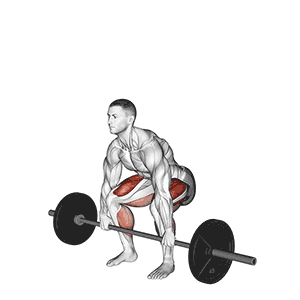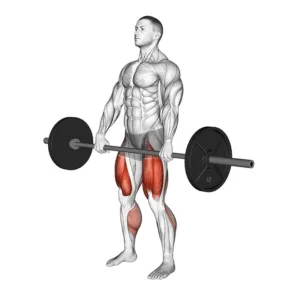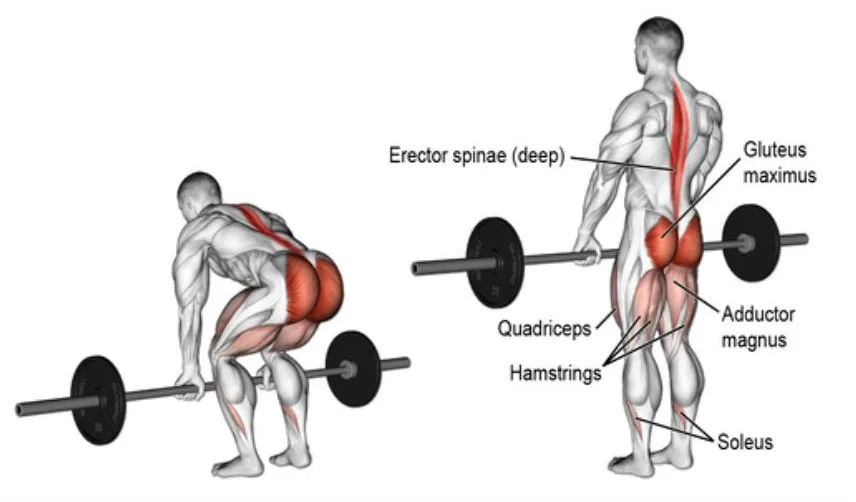 Deadlifting isn’t just an exercise; it's a fundamental movement that taps into the very essence of human kinetic capability and athletic power. If you’re looking to enhance your performance on the field, mastering the deadlift is non-negotiable. Let’s explore how to perform a deadlift with precision and power, and why it's indispensable for any athlete, especially in baseball.
Deadlifting isn’t just an exercise; it's a fundamental movement that taps into the very essence of human kinetic capability and athletic power. If you’re looking to enhance your performance on the field, mastering the deadlift is non-negotiable. Let’s explore how to perform a deadlift with precision and power, and why it's indispensable for any athlete, especially in baseball.
Deadlifts are a powerhouse move that recruit multiple muscle groups across your body – including your back, glutes, hamstrings, and core. This makes it an unparalleled exercise for building strength, improving explosive power, and preventing injury, all critical for the explosive athleticism required in baseball.
Deadlift Technique: A Detailed Step-by-Step Guide

Mastering the deadlift can seem daunting, but with this detailed breakdown, you’ll be pulling with the best. Each step is crucial, so pay close attention to perfect your form and maximize your lifting potential.
Step 1: The Setup for the Deadlift

A proper setup is the foundation of an effective deadlift. Here’s how to nail it:
- Feet Position: Your feet should be set hip-width apart to create a stable base. This width allows most athletes to generate maximum force. Position your feet so that when you look down, the barbell is directly over the middle of your shoelaces, which is typically the point of balance for your foot.
- Grip: Lean over the bar while keeping your back straight and bend at the hips and knees. Your grip should be just outside of your legs, around shoulder-width apart. There are various grips you can use: the double overhand grip for beginners, or the mixed grip for added security as you progress in your lifting journey. Ensure that your grip is firm and your wrists are straight.
- Bar Position: The bar should start over your shoelaces but close enough that it lightly touches your shins. This minimizes the lever arm and reduces strain on the lower back. A bar too far from the shins can also pull you forward, off-balance, and can potentially lead to injury.
Step 2: The Lift of the Deadlift
The lift is where you engage your muscles and move the bar off the ground.
- Brace Your Core: Before you lift, take a deep breath in and brace your core. A braced core acts like a supportive corset around your spine. Keep your spine in a neutral position — avoid rounding or overextending your back.
- Drive Through the Heels: As you begin the lift, focus on driving down through your heels, not the balls of your feet. This drive initiates the movement and engages the powerful muscles in your posterior chain (glutes and hamstrings). Your entire foot should remain in contact with the ground for stability.
- Lift the Bar: Push the ground away from you as you lift, extending your knees and hips simultaneously. Keep the bar as close to your body as possible to improve mechanical leverage. Imagine scraping the bar up your shins and thighs as you rise, although in practice, it should just clear your skin without actually scraping.
Step 3: The Top of the Deadlift

The top of the lift is where you complete the range of motion.
- Lock Out: When the bar passes your knees, it’s crucial to push your hips forward and bring your body to an upright position. This is called ‘locking out’. It’s important not to hyperextend your back at the top; your hips and knees should be straight.
- Shoulders Back: At the top of the lift, pull your shoulders slightly back without changing the position of your hands. This engages the traps and upper back muscles and ensures a strong, stable finish. Your chest should be proud, and your shoulder blades drawn together.
Step 4: The Lower of the Deadlift
Returning the bar to the ground is just as important as lifting it.
- Hinge at the Hips: Start by pushing your hips back. This movement is predominantly a hip hinge and should be initiated before bending your knees.
- Control the Descent: As you lower the bar, keep it close to your body, guiding it down the same path it took on the way up. The descent should be controlled and not too fast; this ensures you maintain tension in your muscles and protects your spine.
- Complete the Move: Bend your knees once the bar passes them and continue to lower the bar by sending your hips back until the weight is on the floor. The bar should land in the same position it started in, ready for the next rep.
Remember, the deadlift is as much a ‘putting down’ exercise as it is a ‘lifting up’ one. A smooth, controlled descent is vital for training the body to handle and dissipate forces effectively.
Perfecting these steps takes practice, patience, and consistency. Video your lifts to review your technique, or work with a coach to get real-time feedback. With this comprehensive guide, the deadlift will soon become one of your strongest and most effective exercises in your athletic development arsenal.

Common Mistakes to Avoid with the Deadlift
- Rounded Back: This can lead to injury. Keep your spine neutral.
- Jerking the Bar: Lift should be smooth and controlled.
- Overextending at the Top: Lock your hips, but don’t lean back at the top.
Programming Deadlifts for Athletes
- Frequency: Incorporate deadlifts 1-2 times per week, allowing for adequate recovery.
- Repetitions: Aim for 3-5 sets of 4-6 repetitions with heavy weights to build strength and power.
- Variations: Include variations like sumo deadlifts or Romanian deadlifts to target different muscle groups.
Safety and Injury Prevention
- Warm-Up: Always start with a dynamic warm-up to prepare your muscles.
- Progress Gradually: Increase the weight progressively, focusing on form.
- Use Proper Equipment: Wear flat shoes and use chalk or straps if necessary for a secure grip.
Understanding Deadlift Standards: What You Should Know

When it comes to deadlifting, gauging how much weight you should be able to lift is important for setting goals and tracking progress. Whether you're just starting out or you've been training for a while, knowing the benchmarks can help keep you motivated and focused.
Deadlift Targets for Different Experience Levels
- For Beginners: If you're new to deadlifting, a commendable initial goal for your one-rep max (1RM) — which is the maximum weight you can lift for one complete repetition — is around 173 pounds. This number isn't just arbitrary; it's a solid starting point that indicates strength above the average untrained individual.
- For Intermediate Lifters: As you advance, a 336-pound deadlift for a one-rep max represents a strong intermediate level. This weight is a substantial milestone and, when achieved, puts you at a strength level that's impressive and well above the norm.
What's the Average and What's Considered Good?
- The Average Deadlift: On average, a 336-pound lift is indicative of a male lifter with a solid strength foundation. This figure is often used as a benchmark to classify an intermediate strength level, suggesting that the lifter has moved beyond the beginner stages of training.
- Aiming for a Good Deadlift: When we talk about a 'good' deadlift, it's all about context. For a male beginner, hoisting up a one-rep max of 173 pounds can be considered an admirable achievement. It's a clear sign that you're making significant strides in your strength journey and setting yourself apart from those without resistance training experience.
Each lifter's journey is unique, and these figures are generalized targets. Progress depends on various factors, including body weight, age, genetics, training frequency, and overall health. Always focus on form and safety over numbers, and remember that consistent training, proper nutrition, and adequate rest are key to your lifting success.
For ore exclusive Topvelocity content join TopVelocity Patreon Pro!
Frequently Asked Questions about Deadlifting
Q: What muscles does the deadlift work? A: The deadlift is a compound exercise that targets multiple muscle groups, including the gluteus maximus, hamstrings, quadriceps, lower back (erector spinae), upper back (trapezius), and forearms (for grip strength).
Q: How often should I deadlift? A: The frequency of deadlifting can vary depending on your fitness level, goals, and overall workout program. Many strength-training regimens include deadlifting once or twice a week.
Q: Is deadlifting safe for my back? A: Yes, when performed correctly, deadlifting is safe and beneficial for strengthening the back muscles. However, improper technique can lead to injury. It is crucial to learn proper form and possibly consult with a fitness professional before incorporating heavy deadlifts into your routine.
Q: Can deadlifting help with weight loss? A: Deadlifting can contribute to weight loss as part of a comprehensive exercise program that includes both strength and cardiovascular training, along with a balanced diet.
Q: What is the difference between sumo and conventional deadlifts? A: The main difference lies in the stance and hand positioning. The sumo deadlift has a wider stance with hands placed inside the legs, targeting more of the glutes and inner thighs. The conventional deadlift uses a narrower stance with hands outside the legs, placing more emphasis on the lower back and hamstrings.
Q: How much weight should I start with when deadlifting? A: Beginners should start with a light weight to focus on proper form. This might be just the barbell itself (often 45 pounds) or a slight addition of weight. Progress should be gradual to prevent injury.
Q: What equipment do I need for deadlifting? A: The essential equipment for deadlifting includes a barbell and weight plates. For additional support and safety, many lifters also use a weightlifting belt, wrist straps, chalk for grip, and proper shoes with minimal cushioning.
Q: Can deadlifts replace squats in a workout routine? A: While both exercises are effective for building lower body strength, they target different muscles and have distinct movement patterns. They are best used in conjunction as part of a balanced workout plan rather than one replacing the other.
Q: Are there any variations of the deadlift that I can try? A: Yes, there are several variations, such as the Romanian deadlift (targeting hamstrings and glutes with less knee bend), stiff-legged deadlift (similar to the Romanian but with legs kept straighter), and trap bar deadlift (using a diamond-shaped bar, which may reduce strain on the lower back).
Q: How can I prevent my grip from giving out during heavy lifts? A: To prevent grip failure, you can train your grip strength separately, use mixed or hook grips, and incorporate grip aids like chalk or lifting straps as needed.



